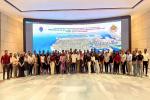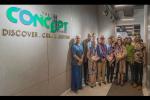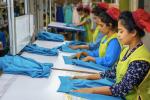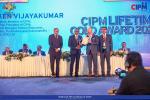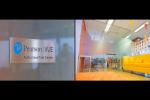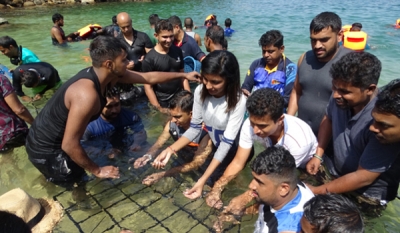Until 1998, the Bonavista reef was recognized as one of the highest biologically diverse coral reefs and was considered a pristine marine environment to be thoroughly protected.
Although corals spread covers only 1% of the ocean, it provides protective areas for 25% of sea animals.
Due to the El-Nino caused in 1998 and 2016, 95% of the live coral cover in the Bonavista reef was destroyed.
With an objective to rebuild the biodiversity of the Bonavista reef to the pristine level it used to be, DIMO initiated a conservation and restoration project in 2017 with the technical support of Wildlife and Ocean Resource Conservation (WORC).
Over the last two years DIMO has restored an area of 2 1/2 acres by planting new corals where they are most suited and needed.
So far more than 1500 nubbins have been planted and 04 nursery panels and 01 steel rack have been deposited under the sea, including the 120 nubbins and 2 nursery panels that were planted on the season 3.
Chairman & Managing Director Of DIMO, Ranjith Pandithage said “The objective of “Life to Reef” project stands out as extending DIMO’s collective responsibility outside the business boundaries.
Another significant feature of this environment protection and biodiversity conservation program is that it is directly aligned with the Sustainable Development Goal #14: Life below water, as declared by the United Nations”.
The corals planted in 2017 which were not more than 5cm long have now grown by about 15cm and divided into 25-30 branches.
According to a survey done by WORC after the second year’s restoration activities, 200 reef associated fish species were recorded against the 70 reef species which were present before the restoration activities.
The frequent sighting of butterfly fish (Chaetodontidae) species who depend on coral diversity is a great example for enhanced biological diversity in Bonavista reef.
At present 8 butterfly fish species can be observed in Bonavista reef.
Among the other species who can be observed in the reef are snapper, angelfish, squirrelfish, lionfish and cardinalfish.
Currently about 25 coral species are recorded in Rumassala reef and DIMO is proud to have made an impact with the restoration project.
DIMO’s “Life to Reef” Season 3 was an exciting and fun-filled day for DIMO volunteers recording a total of 459 volunteer hours.
They contributed towards the project in different capacities; as divers, snorkelers, swimmers and underwater photographers.
The replanting of corals involved many novel methods in which volunteers could get involved in different ways.
These methods were experimented and found to be successful by WORC.
The corals tied up in cement plates and nursery racks were taken to the deep waters by divers from DIMO and deposited at the bottom of the sea.
They were also able to witness the growth of previously planted corals and how they have adapted to the eco-system, delivering the desired results of previous years.
With the improvements in the restoration of the Bonavista reef, more tourists, local and foreign divers and snorkelers are now arriving to observe the corals.
DIMO’s “Life to Reef” project has also indirectly created livelihood opportunities to the nearby community where they have started to rent out snorkeling kits and some villagers have established small food stalls targeting these tourists while others provide accommodation facilities for tourists.
DIMO “Life to Reef” initiative focuses on recovering damaged coral reefs by monitoring, cleaning and replanting within the reef area while creating artificial coral reefs using the dead reefs.
Other aspect of the project is building awareness among the community in the project area on coral protection and sustainability.
Active participation of voluntary staff in this sustainable initiative is a pivotal factor for DIMO.
The long-term goal and ultimate objective of DIMO “Life to Reef” project is to enhance the biodiversity in the reef to a state where the Department of Wildlife can enforce necessary laws and regulations to make it a protected area.




